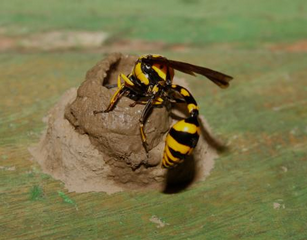The Obscure Wisdom of the Potter Wasp
E. L. Grant Watson
Among the fascinating stories of animal life told by the French naturalist Henri Fabre is that of the sand wasp Eumenes [usually referred to as the potter wasp]. The fertilized female builds a little domed house of sand spicules on some stone or rock foundation. The foundation ring is traced in minute pebbles. On this she builds a series of concentric rings, each diminishing in circumference, so as to enclose a domed space. At the top she leaves a hole. She then begins collecting certain species of small caterpillars. She stings these into a partial paralysis, but does not kill them, for they will be needed as fresh meat for the young she will never see.
When the wasp has collected either five or ten caterpillars, she prepares to close the dome, reducing the size of the hole. She now goes through a complicated process which would seem to indicate foresight on her part. Yet she has no foresight, only a highly developed instinct. From her ovipositor she excretes a juicy substance, working it with her legs into a narrow, inverted cone. With a thread of the same substance, she stitches the cone to the top of her domed building. Into the inverted cone, she lays an egg. She then seals up the hole, leaving the egg safe within the cone, suspended on a thread. This done, she goes off and builds another dome to repeat the same cycle of events.
In a short time the egg hatches into a tiny, white grub, so helpless and delicate that if placed among the still-living caterpillars on the floor of the dome, it would inevitably be injured. In its cradle it is safe. When hungry it spins a thin thread of its own, on which it descends and takes a bite of caterpillar. If the wriggling caterpillars appear threatening, it can retreat up the thread, and wait. In this way the grub spends its infancy; but, as it grows stronger, it risks a final descent, and devours, at its leisure, the still living food that mother has so satisfactorily provided.
From the domes that contain five caterpillars male wasps emerge; from where there are ten caterpillars, the larger female wasps. This raises an interesting question: Does the amount of food determine the sex? The mother wasp, who appears throughout her lifetime as a highly nervous and brilliantly alive creature, has built just the right sort of houses for the offspring she will never see; and has provided just the right amount of food. She is singularly well-adapted for her life; she stings the caterpillars just enough to keep them quiet, but not enough to kill them; she packs each dome with the right amount of food for male or female grub. The suspended cradle protects the tender infant from the rough reactions of the caterpillars while being eaten. Everything is in order, and as the emerging sand wasp dries her wings in the summer sunshine, she must surely feel that God is in his heaven, and all is well with the world. The caterpillars might harbour different sentiments....
The generally accepted belief is that the sex is already determined by the arrangement of genes in the fertilized egg. If this is so, the wasp must be controlled by an infallible guide within the unconscious working of her body as to the sex of the egg she will be ready to lay when her dome is completed. Nature certainly propounds puzzles for any who would suggest premature answers.
(From E.L. Grant Watson's The Physical Mystery of Life, Hudson, N.Y.: Lindisfarne Press, 1964. Originally published in 1943. Reprinted by permission.)
Original source: In Context (Spring, 1999, p. 18), published by The Nature Institute

